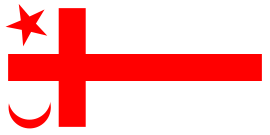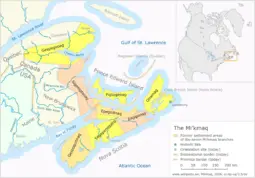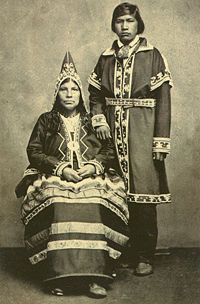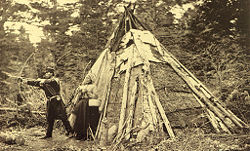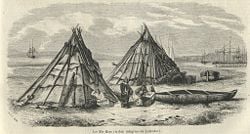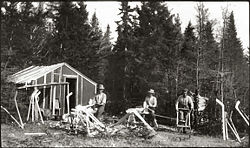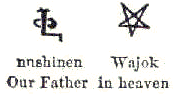Difference between revisions of "Mi'kmaq" - New World Encyclopedia
| Line 17: | Line 17: | ||
[[Image:The Mi'kmaq.png|right|thumb|right|255px|The Mi'kmaq]] | [[Image:The Mi'kmaq.png|right|thumb|right|255px|The Mi'kmaq]] | ||
| − | The '''Mi'kmaq''' ({{IPA|[miːgmaɣ]}}; (also spelled '''Míkmaq, Mi'gmaq, Micmac''' or '''MicMac''') are a [[First Nations]] people, indigenous to northeastern [[New England]], [[Canada]]'s [[Atlantic Provinces]], and the [[Gaspé Peninsula]] of [[Quebec]]. The word '''Míkmaw''' is an adjectival form of the plural noun for the people, ''Míkmaq''. Mi'kmaq are self-recognized as '''L'nu''' (in the singular; the plural is '''Lnu'k'''). ([http://museum.gov.ns.ca/mikmaq/ The Nova Scotia Museum's Mi'kmaq Portraits database]). The name ''Mi'kmaq'' comes from a word in their language meaning "allies." | + | The '''Mi'kmaq''' ({{IPA|[miːgmaɣ]}}; (also spelled '''Míkmaq, Mi'gmaq, Micmac''' or '''MicMac''') are a [[First Nations]]/[[Native Americans in the United States|Native American]] people, indigenous to northeastern [[New England]], [[Canada]]'s [[Atlantic Provinces]], and the [[Gaspé Peninsula]] of [[Quebec]]. The word '''Míkmaw''' is an adjectival form of the plural noun for the people, ''Míkmaq''. Mi'kmaq are self-recognized as '''L'nu''' (in the singular; the plural is '''Lnu'k'''). ([http://museum.gov.ns.ca/mikmaq/ The Nova Scotia Museum's Mi'kmaq Portraits database]). The name ''Mi'kmaq'' comes from a word in their language meaning "allies." |
==Population== | ==Population== | ||
| Line 46: | Line 46: | ||
|----- bgcolor="#EFEFEF" | |----- bgcolor="#EFEFEF" | ||
|} | |} | ||
| − | The pre-contact population is estimated at 35,000. In 1616 Father Biard believed the Mi'kmaq population to be in excess of 3.000. But he remarked that, because of European diseases, there had been large population losses in the last century. | + | The pre-contact Mi'kmaq population is estimated at 35,000. In 1616 Father Biard believed the Mi'kmaq population to be in excess of 3.000. But he remarked that, because of European diseases, there had been large population losses in the last century. |
| + | |||
[[Smallpox]], wars and alcoholism led to a further decline of the native population, which was probably at its lowest in the middle of the 17th century. Then the numbers grew slightly again and seemed to be stable during the 19th century. In the 20th century the population was on the rise again. The average growth from 1965 to 1970 was about 2.5%. | [[Smallpox]], wars and alcoholism led to a further decline of the native population, which was probably at its lowest in the middle of the 17th century. Then the numbers grew slightly again and seemed to be stable during the 19th century. In the 20th century the population was on the rise again. The average growth from 1965 to 1970 was about 2.5%. | ||
==History== | ==History== | ||
| − | The Mi'kmaq were members of the ''Waponahkiyik'' ([[Wabanaki]] Confederacy), an alliance with four other Algonquin nations: the [[Abenaki]], [[Penobscot]], [[Passamaquoddy]], and [[Maliseet]]. At the time of contact with the French (late 1500s) they were expanding from their Maritime base westward along the Gaspé Peninsula /St. Lawrence River at the expense of [[Iroquois|Iroquioian]] [[Mohawk]] tribes, hence the Mi'kmaq name for this peninsula, ''Gespedeg'' ("last-acquired"). In 1610, Chief [[Membertou]] concluded their first alliance with Europeans, a concordat with the French [[Jesuit]]s that affirmed the right of Mi'kmaq to choose [[Catholicism]], Mi'kmaq tradition, or both. | + | [[Image:Micmac2.jpg|thumb|left|200 px|Mann und Frau der Micmac, Neuschottland, 1865]] |
| + | The Mi'kmaq were members of the ''Waponahkiyik'' ([[Wabanaki]] Confederacy), an alliance with four other Algonquin nations: the [[Abenaki]], [[Penobscot]], [[Passamaquoddy]], and [[Maliseet]]. At the time of contact with the French (late 1500s) they were expanding from their Maritime base westward along the Gaspé Peninsula /St. Lawrence River at the expense of [[Iroquois|Iroquioian]] [[Mohawk]] tribes, hence the Mi'kmaq name for this peninsula, ''Gespedeg'' ("last-acquired"). | ||
| + | |||
| + | [[Image:Micmac1.jpg|thumb|right|250 px|Traditioneller Wigwam der Micmac, 1873.]] | ||
| + | In 1610, Chief [[Membertou]] concluded their first alliance with Europeans, a concordat with the French [[Jesuit]]s that affirmed the right of Mi'kmaq to choose [[Catholicism]], Mi'kmaq tradition, or both. | ||
| + | |||
| + | '''Henri Membertou''' (died 18 September 1611) was the ''sakmow'' (Grand Chief) of the Mi'kmaq tribe situated near Port Royal, site of the first [[France|French]] settlement in [[Acadia]], present-day [[Nova Scotia]], [[Canada]]. Originally ''sakmow'' of the Kespukwitk district, he was appointed as Grand Chief by the ''sakmowk'' of the other six districts.His exact date of birth is not known. However, Membertou claimed to be a grown man when he first met Jacques Cartier, which would mean that he was probably born in the early years of the sixteenth century.<ref name=bumsted> Bumsted, J.M. (2007). ''A History of the Canadian Peoples.'' Canada: Oxford University Press. ISBN 0-19-542349-6 </ref> | ||
| + | |||
| + | Membertou was the leader of a small band of Mi'kmaq whose hunting and fishing territory included the area of Port-Royal.<ref name=bumsted/> In addition to being ''sakmow'' or political leader, Membertou had also been the head ''autmoin'' or spiritual leader of his tribe — who believed him to have powers of healing and prophecy. Both Lescarbot and explorer [[Samuel de Champlain]] wrote of having witnessed him conducting a funeral in 1606 for Panoniac, a fellow Mi'kmaw ''sakmow'' who had been killed by the Armouchiquois or [[Passamaquoddy]] tribe, of what is now Maine. Seeking revenge for this and similar acts of hostility, Membertou led some 500 warriors in a raid on the Armouchiquois town, Chouacoet, present-day [[Saco, Maine]], in July, 1607, killing 20 of their braves, including two of their leaders, Onmechin and Marchin. He first met the French when they arrived to build the [[Habitation at Port-Royal]] in 1605, at which time, according to the French lawyer and author [[Marc Lescarbot]], he said he was over 100 and recalled meeting [[Jacques Cartier]] in 1534. Membertou became a good friend to the French. Father Biard described him as being tall and large limbed compared to the other natives. It is also said that he had a beard in contrast to the others who removed any facial hair.<ref name=bumsted/> Also, unlike most ''sakmowk'' who were polygamous, Membertou had only one wife, who was baptised with the name of "Marie." Lescarbot records that the eldest son of Chief Membertou had the name Membertouchis (Membertouji'j, baptised Louis Membertou after the then-King of France, [[Louis XIII]]), while his second and third sons were called Actaudin (absent at the time of the baptism) and Actaudinech (Actaudinji'j, baptised Paul Membertou). He also had a daughter, given the name Marguerite. After building their fort, the French left in 1607, leaving only two of their party behind, during which time Membertou took good care of the fort and them, meeting them upon their return in 1610. | ||
| + | |||
| + | On June 24th 1610 (Saint John the Baptist Day), Membertou became the first Aboriginal to be baptised in New France. The ceremony was carried out by priest Jessé Fléché. He had just arrived from New France and he went on to baptize all of Membertou's immediate family. There was no proper preparation due to the fact that priest Jessé Fléché did not speak the Algonquian language and on their part, the Aboriginals did not speak enough French. It was then that Membertou was given the baptized name of the late king of France, Henri.<ref name=bumsted/> This was a sign of alliance and good faith. | ||
| + | |||
| + | Membertou was very eager to become a proper Christian as soon as he was baptized. He wanted the missionaries to learn the Algonquian language so that he could be properly educated.<ref name=bumsted/> Biard relates how, when Membertou's son Actaudin became gravely ill, he was prepared to sacrifice two or three dogs to precede him as messengers into the spirit world, but when Biard told him this was wrong, he did not, and Actaudin then recovered. However, in 1611, he contracted dysentry which is one of the many infectious diseases that was brought and spread in the New World by the Europeans. By September 1611, he was very ill. Membertou insisted on being buried with his ancestors, something that bothered the missionaries. Finally, Membertou changed his mind and requested to be buried among the French.<ref name=bumsted/> In his final words he charged his children to remain devout Christians. | ||
| + | The last year of Membertou's life shows a pattern that emerged among the indigenous people that were "Christianized" by European missionaries. They did not understand the principles of Christianity thus they could hardly have been said to be converted. They often died shortly after they were baptized and usually dying from the contagious diseases that were usually introduced by the missionaries themselves.<ref name=bumsted/> | ||
| + | [[Image:No53p253 micmacs-e02-tribus indigene du labrador.jpg|thumb|250 px|Illustration published as part of the article Tribu des Mic-Macs, Mac Vernoll, in Le Monde illustré, n°53, 17/04/1858.]] | ||
The Mi'kmaq were allies with the French, and were amenable to limited French settlement in their midst. But as France lost control of [[Acadia]] in the early 1700s, they soon found themselves overwhelmed by [[Briton|British]] ([[English people|English]], [[Irish people|Irish]], [[Scottish people|Scottish]], [[Welsh people|Welsh]]) who seized much of the land without payment and deported the French. Between 1725 and 1779, the Mi'kmaq signed a series of [[peace]] and friendship [[treaties]] with [[Great Britain]], but none of these were land cession treaties. The nation historically consisted of seven [[districts]], but this was later expanded to eight with the ceremonial addition of Great Britain at the time of the 1749 treaty. Later on the Mi'kmaq also settled [[Newfoundland]] as the unrelated [[Beothuk]] tribe became extinct. Mi'kmaq representatives also concluded the first international treaty with the [[United States]] after its declaration of independence, the [[Treaty of Watertown]]. | The Mi'kmaq were allies with the French, and were amenable to limited French settlement in their midst. But as France lost control of [[Acadia]] in the early 1700s, they soon found themselves overwhelmed by [[Briton|British]] ([[English people|English]], [[Irish people|Irish]], [[Scottish people|Scottish]], [[Welsh people|Welsh]]) who seized much of the land without payment and deported the French. Between 1725 and 1779, the Mi'kmaq signed a series of [[peace]] and friendship [[treaties]] with [[Great Britain]], but none of these were land cession treaties. The nation historically consisted of seven [[districts]], but this was later expanded to eight with the ceremonial addition of Great Britain at the time of the 1749 treaty. Later on the Mi'kmaq also settled [[Newfoundland]] as the unrelated [[Beothuk]] tribe became extinct. Mi'kmaq representatives also concluded the first international treaty with the [[United States]] after its declaration of independence, the [[Treaty of Watertown]]. | ||
==Culture== | ==Culture== | ||
| − | + | [[Image:Mikmac-hockey-sticks.jpg|thumb|250 px|left|Photograph of Mi'kmaq making hockey sticks from hornbeam trees (Carpinus caroliniana) in Nova Scotia.]] | |
| − | |||
| − | |||
| − | |||
Members of the Mi'kmaq [[First Nation]] historically referred to themselves as L'nu, meaning [[human]] being.<ref>[http://museum.gov.ns.ca/mikmaq/ The Nova Scotia Museum's Mi'kmaq Portraits database]</ref> But, the Mi'kmaq's [[France|French allies]], whom the Mi'kmaq referred to as Ni'kmaq, meaning "my kin," initially referred to the Mi'kmaq, (as is written in ''[[Relations des Jésuites de la Nouvelle-France]]'') as "[[Souriquois]]" (the Souricoua River was a travel route between the Bay of Fundy and the Gulf of St. Lawrence) or "[[Gaspesians]]." Over time their French allies and succeeding immigrating nations’ peoples began to refer to the Lnu'k as Ni’knaq, (invariably corrupting the word to various spellings such as Mik Mak, Mic Mac, etc.) The British originally referred to them as [[Tarrantine]]s.<ref>{{cite web |last=Lydia Affleck and Simon White |title=Our Language | work=Native Traditions | url=http://www.peicaps.org/betweengen/circle/language.html | accessdate=2006-11-08}}</ref> | Members of the Mi'kmaq [[First Nation]] historically referred to themselves as L'nu, meaning [[human]] being.<ref>[http://museum.gov.ns.ca/mikmaq/ The Nova Scotia Museum's Mi'kmaq Portraits database]</ref> But, the Mi'kmaq's [[France|French allies]], whom the Mi'kmaq referred to as Ni'kmaq, meaning "my kin," initially referred to the Mi'kmaq, (as is written in ''[[Relations des Jésuites de la Nouvelle-France]]'') as "[[Souriquois]]" (the Souricoua River was a travel route between the Bay of Fundy and the Gulf of St. Lawrence) or "[[Gaspesians]]." Over time their French allies and succeeding immigrating nations’ peoples began to refer to the Lnu'k as Ni’knaq, (invariably corrupting the word to various spellings such as Mik Mak, Mic Mac, etc.) The British originally referred to them as [[Tarrantine]]s.<ref>{{cite web |last=Lydia Affleck and Simon White |title=Our Language | work=Native Traditions | url=http://www.peicaps.org/betweengen/circle/language.html | accessdate=2006-11-08}}</ref> | ||
| Line 72: | Line 84: | ||
[[Image:micmac-confirmation.jpg|frame|right|Text of the Rite of Confirmation in Mi'kmaq hieroglyphs. The text reads ''Koqoey nakla msɨt telikaqumila’laji?'' – literally 'Why / those / all / after he did that to them?', or "Why are all these different steps necessary?"]] | [[Image:micmac-confirmation.jpg|frame|right|Text of the Rite of Confirmation in Mi'kmaq hieroglyphs. The text reads ''Koqoey nakla msɨt telikaqumila’laji?'' – literally 'Why / those / all / after he did that to them?', or "Why are all these different steps necessary?"]] | ||
| − | |||
| − | |||
| − | |||
[[Image:Our Father in heaven - Mikmaq hierogl.gif|frame|right|The beginning of the Lord's Prayer in Mi'kmaq hieroglyphs. The text reads ''Nujjinen wa’so’q'' – "Our father / in heaven"]] | [[Image:Our Father in heaven - Mikmaq hierogl.gif|frame|right|The beginning of the Lord's Prayer in Mi'kmaq hieroglyphs. The text reads ''Nujjinen wa’so’q'' – "Our father / in heaven"]] | ||
| − | Father le Clercq, a [[Roman Catholic]] missionary on the [[Gaspé Peninsula]] from 1675, claimed that he had seen some Mi'kmaq children 'writing' [[birch bark document|symbols on birchbark]] as a memory aid. This was sometimes done by pressing porcupine quills directly into the bark in the shape of symbols. Le Clercq adapted those symbols to writing prayers, developing new symbols as necessary. This writing system proved popular among Mi'kmaq, and was still in use in the [[19th century]]. Since there is no historical or archaeological evidence of these symbols from before the arrival of this missionary, it is unclear how ancient the use of the mnemonic glyphs was. The relationship of these symbols with Mi'kmaq | + | Father le Clercq, a [[Roman Catholic]] missionary on the [[Gaspé Peninsula]] from 1675, claimed that he had seen some Mi'kmaq children 'writing' [[birch bark document|symbols on birchbark]] as a memory aid. This was sometimes done by pressing porcupine quills directly into the bark in the shape of symbols. Le Clercq adapted those symbols to writing prayers, developing new symbols as necessary. This writing system proved popular among Mi'kmaq, and was still in use in the [[19th century]]. Since there is no historical or archaeological evidence of these symbols from before the arrival of this missionary, it is unclear how ancient the use of the mnemonic glyphs was. The relationship of these symbols with Mi'kmaq [[petroglyph]]s is also unclear. |
| − | === | + | ==Contemporary== |
| − | |||
| − | |||
| − | |||
| − | |||
| − | |||
| − | |||
| − | |||
| − | |||
| − | |||
| − | |||
| − | |||
| − | |||
| − | |||
| − | |||
| − | |||
| − | |||
| − | |||
| − | |||
| − | |||
| − | |||
| − | |||
| − | |||
| − | |||
| − | |||
| − | |||
| − | |||
| − | |||
| − | |||
| − | |||
| − | |||
| − | |||
| − | |||
| − | |||
| − | |||
| − | |||
| − | |||
| − | |||
| − | |||
| − | |||
| − | |||
| − | |||
| − | |||
| − | |||
| − | |||
| − | |||
| − | |||
| − | |||
| − | |||
| − | |||
| − | |||
| − | |||
| − | |||
| − | |||
| − | |||
| − | |||
| − | |||
| − | |||
| − | |||
| − | |||
| − | |||
| − | |||
| − | |||
| − | |||
| − | |||
| − | |||
| − | |||
| − | |||
The Nation MicMac currently has a population of about 40,000 of whom approximately one-third still speak the [[Algonquian]] language [[Míkmaq language|Lnuísimk]] which was once written in [[Míkmaq hieroglyphic writing]] and is now written using most letters of the standard [[Latin alphabet]]. | The Nation MicMac currently has a population of about 40,000 of whom approximately one-third still speak the [[Algonquian]] language [[Míkmaq language|Lnuísimk]] which was once written in [[Míkmaq hieroglyphic writing]] and is now written using most letters of the standard [[Latin alphabet]]. | ||
| − | |||
| − | |||
| − | |||
| − | |||
| − | |||
| − | |||
| − | |||
| − | |||
| − | |||
| − | |||
| + | The spiritual capital of the Mi'kmaq nation is the gathering place of the Mi'kmaq Grand Council, Mniku or Chapel Island in the [[Bras d'Or Lakes]] of [[Cape Breton Island]]. The island also the site of the St. Anne Mission, an important pilgrimage site for the Mi'kmaq. The island has been declared a historic site. | ||
| + | In the Canadian provinces of [[Nova Scotia]] and [[Newfoundland and Labrador]] October is celebrated as Mi'kmaq History Month and the entire Nation celebrates Treaty Day annually on October 1st. '''L’nu''' (Lnu'k - plural form) is the self-recognized term for the Mi'kmaq of [[New Brunswick]], [[Newfoundland]], Nova Scotia, [[Quebec]] and [[Maine]], [[United States]]. | ||
==Notes== | ==Notes== | ||
<references /> | <references /> | ||
| − | |||
| − | |||
| − | |||
| − | |||
==References== | ==References== | ||
| Line 178: | Line 108: | ||
* Wicken, William C. 2002. ''Mi'kmaq Treaties on Trial: History, Land, and Donald Marshall Junior'', University of Toronto Press. | * Wicken, William C. 2002. ''Mi'kmaq Treaties on Trial: History, Land, and Donald Marshall Junior'', University of Toronto Press. | ||
| − | + | * Bumsted, J.M. (2007). ''A History of the Canadian Peoples.'' Canada: Oxford University Press. ISBN 0-19-542349-6 | |
* Chaisson, Paul, ''The Island of Seven Cities: where the Chinese settled when they discovered North America'', Random House Canada, 2006, p. 170. | * Chaisson, Paul, ''The Island of Seven Cities: where the Chinese settled when they discovered North America'', Random House Canada, 2006, p. 170. | ||
| Line 188: | Line 118: | ||
* Schmidt, David L., and Murdena Marshall. 1995. ''Mi'kmaq Hieroglyphic Prayers: Readings in North America's First Indigenous Script''. Nimbus Publishing. ISBN 1-55109-069-4 | * Schmidt, David L., and Murdena Marshall. 1995. ''Mi'kmaq Hieroglyphic Prayers: Readings in North America's First Indigenous Script''. Nimbus Publishing. ISBN 1-55109-069-4 | ||
| + | ==External links== | ||
| − | |||
| − | |||
| − | |||
| − | |||
| − | |||
| − | |||
* [http://www.dickshovel.com/mic.html Micmac History] | * [http://www.dickshovel.com/mic.html Micmac History] | ||
* [http://www.snws.ednet.ns.ca/mi%27kmaq.htm Mi'kmaq History Month] | * [http://www.snws.ednet.ns.ca/mi%27kmaq.htm Mi'kmaq History Month] | ||
| Line 200: | Line 125: | ||
* [http://www.mikmaqonline.org/ Mi'kmaq Dictionary Online] | * [http://www.mikmaqonline.org/ Mi'kmaq Dictionary Online] | ||
* [http://www.blupete.com/Hist/Gloss/Indians.htm The Micmac of Megumaagee] | * [http://www.blupete.com/Hist/Gloss/Indians.htm The Micmac of Megumaagee] | ||
| − | + | * [http://www.accessgenealogy.com/native/tribes/micmac/micmachist.htm Micmac Indian Tribe History] | |
*[http://museum.gov.ns.ca/mikmaq/1500ind.htm Mi'kmaq Portraits Collection] Includes tracings and images of Mi'kmaq petroglyphs | *[http://museum.gov.ns.ca/mikmaq/1500ind.htm Mi'kmaq Portraits Collection] Includes tracings and images of Mi'kmaq petroglyphs | ||
*[http://www.christusrex.org/www1/pater/JPN-micmac.html Micmac at ChristusRex.org] A large collection of scans of prayers in Mi'kmaq hieroglyphs. | *[http://www.christusrex.org/www1/pater/JPN-micmac.html Micmac at ChristusRex.org] A large collection of scans of prayers in Mi'kmaq hieroglyphs. | ||
*[http://www.vjf.cnrs.fr/celia/FichExt/Am/A_19-20_34.pdf Écriture sacrée en Nouvelle France: Les hiéroglyphes micmacs et transformation cosmologique] (PDF, in French) A discussion of the origins of Mi'kmaq hieroglyphs and sociocultural change in 17th century Micmac society. | *[http://www.vjf.cnrs.fr/celia/FichExt/Am/A_19-20_34.pdf Écriture sacrée en Nouvelle France: Les hiéroglyphes micmacs et transformation cosmologique] (PDF, in French) A discussion of the origins of Mi'kmaq hieroglyphs and sociocultural change in 17th century Micmac society. | ||
| + | * [http://www.folkstreams.net/film,94 Our Lives in Our Hands] Documentary film of Mi'kmaq basketmakers and potato diggers in northern Maine, 1986 | ||
| + | *[http://www.biographi.ca/EN/ShowBio.asp?BioId=34530 Biography at the ''Dictionary of Canadian Biography Online''] | ||
| − | {{credits|Mic_Mac|141079114|Mi'kmaq_hieroglyphic_writing|157119982|}} | + | {{credits|Mic_Mac|141079114|Mi'kmaq_hieroglyphic_writing|157119982|Henri_Membertou|161678463}} |
Revision as of 00:35, 10 November 2007
| Mi'kmaq |
|---|
| Míkmaq State flag |
| Total population |
| 40,000 |
| Regions with significant populations |
| Canada (New Brunswick, Newfoundland and Labrador, Nova Scotia, Prince Edward Island, Quebec), United States (Maine) |
| Languages |
| English, Míkmaq, French |
| Religions |
| Christianity, other |
| Related ethnic groups |
| other Algonquian peoples |
The Mi'kmaq ([miːgmaɣ]; (also spelled Míkmaq, Mi'gmaq, Micmac or MicMac) are a First Nations/Native American people, indigenous to northeastern New England, Canada's Atlantic Provinces, and the Gaspé Peninsula of Quebec. The word Míkmaw is an adjectival form of the plural noun for the people, Míkmaq. Mi'kmaq are self-recognized as L'nu (in the singular; the plural is Lnu'k). (The Nova Scotia Museum's Mi'kmaq Portraits database). The name Mi'kmaq comes from a word in their language meaning "allies."
Population
| Year | Population | Verification |
|---|---|---|
| 1500 | 4.500 | Estimation |
| 1600 | 3.000 | Estimation |
| 1700 | 2.000 | Estimation |
| 1750 | 3.000 | Estimation |
| 1800 | 3.100 | Estimation |
| 1900 | 4.000 | Census |
| 1940 | 5.000 | Census |
| 1960 | 6.000 | Census |
| 1972 | 9.800 | Census |
| 2000 | 20.000 | Estimation |
The pre-contact Mi'kmaq population is estimated at 35,000. In 1616 Father Biard believed the Mi'kmaq population to be in excess of 3.000. But he remarked that, because of European diseases, there had been large population losses in the last century.
Smallpox, wars and alcoholism led to a further decline of the native population, which was probably at its lowest in the middle of the 17th century. Then the numbers grew slightly again and seemed to be stable during the 19th century. In the 20th century the population was on the rise again. The average growth from 1965 to 1970 was about 2.5%.
History
The Mi'kmaq were members of the Waponahkiyik (Wabanaki Confederacy), an alliance with four other Algonquin nations: the Abenaki, Penobscot, Passamaquoddy, and Maliseet. At the time of contact with the French (late 1500s) they were expanding from their Maritime base westward along the Gaspé Peninsula /St. Lawrence River at the expense of Iroquioian Mohawk tribes, hence the Mi'kmaq name for this peninsula, Gespedeg ("last-acquired").
In 1610, Chief Membertou concluded their first alliance with Europeans, a concordat with the French Jesuits that affirmed the right of Mi'kmaq to choose Catholicism, Mi'kmaq tradition, or both.
Henri Membertou (died 18 September 1611) was the sakmow (Grand Chief) of the Mi'kmaq tribe situated near Port Royal, site of the first French settlement in Acadia, present-day Nova Scotia, Canada. Originally sakmow of the Kespukwitk district, he was appointed as Grand Chief by the sakmowk of the other six districts.His exact date of birth is not known. However, Membertou claimed to be a grown man when he first met Jacques Cartier, which would mean that he was probably born in the early years of the sixteenth century.[1]
Membertou was the leader of a small band of Mi'kmaq whose hunting and fishing territory included the area of Port-Royal.[1] In addition to being sakmow or political leader, Membertou had also been the head autmoin or spiritual leader of his tribe — who believed him to have powers of healing and prophecy. Both Lescarbot and explorer Samuel de Champlain wrote of having witnessed him conducting a funeral in 1606 for Panoniac, a fellow Mi'kmaw sakmow who had been killed by the Armouchiquois or Passamaquoddy tribe, of what is now Maine. Seeking revenge for this and similar acts of hostility, Membertou led some 500 warriors in a raid on the Armouchiquois town, Chouacoet, present-day Saco, Maine, in July, 1607, killing 20 of their braves, including two of their leaders, Onmechin and Marchin. He first met the French when they arrived to build the Habitation at Port-Royal in 1605, at which time, according to the French lawyer and author Marc Lescarbot, he said he was over 100 and recalled meeting Jacques Cartier in 1534. Membertou became a good friend to the French. Father Biard described him as being tall and large limbed compared to the other natives. It is also said that he had a beard in contrast to the others who removed any facial hair.[1] Also, unlike most sakmowk who were polygamous, Membertou had only one wife, who was baptised with the name of "Marie." Lescarbot records that the eldest son of Chief Membertou had the name Membertouchis (Membertouji'j, baptised Louis Membertou after the then-King of France, Louis XIII), while his second and third sons were called Actaudin (absent at the time of the baptism) and Actaudinech (Actaudinji'j, baptised Paul Membertou). He also had a daughter, given the name Marguerite. After building their fort, the French left in 1607, leaving only two of their party behind, during which time Membertou took good care of the fort and them, meeting them upon their return in 1610.
On June 24th 1610 (Saint John the Baptist Day), Membertou became the first Aboriginal to be baptised in New France. The ceremony was carried out by priest Jessé Fléché. He had just arrived from New France and he went on to baptize all of Membertou's immediate family. There was no proper preparation due to the fact that priest Jessé Fléché did not speak the Algonquian language and on their part, the Aboriginals did not speak enough French. It was then that Membertou was given the baptized name of the late king of France, Henri.[1] This was a sign of alliance and good faith.
Membertou was very eager to become a proper Christian as soon as he was baptized. He wanted the missionaries to learn the Algonquian language so that he could be properly educated.[1] Biard relates how, when Membertou's son Actaudin became gravely ill, he was prepared to sacrifice two or three dogs to precede him as messengers into the spirit world, but when Biard told him this was wrong, he did not, and Actaudin then recovered. However, in 1611, he contracted dysentry which is one of the many infectious diseases that was brought and spread in the New World by the Europeans. By September 1611, he was very ill. Membertou insisted on being buried with his ancestors, something that bothered the missionaries. Finally, Membertou changed his mind and requested to be buried among the French.[1] In his final words he charged his children to remain devout Christians.
The last year of Membertou's life shows a pattern that emerged among the indigenous people that were "Christianized" by European missionaries. They did not understand the principles of Christianity thus they could hardly have been said to be converted. They often died shortly after they were baptized and usually dying from the contagious diseases that were usually introduced by the missionaries themselves.[1]
The Mi'kmaq were allies with the French, and were amenable to limited French settlement in their midst. But as France lost control of Acadia in the early 1700s, they soon found themselves overwhelmed by British (English, Irish, Scottish, Welsh) who seized much of the land without payment and deported the French. Between 1725 and 1779, the Mi'kmaq signed a series of peace and friendship treaties with Great Britain, but none of these were land cession treaties. The nation historically consisted of seven districts, but this was later expanded to eight with the ceremonial addition of Great Britain at the time of the 1749 treaty. Later on the Mi'kmaq also settled Newfoundland as the unrelated Beothuk tribe became extinct. Mi'kmaq representatives also concluded the first international treaty with the United States after its declaration of independence, the Treaty of Watertown.
Culture
Members of the Mi'kmaq First Nation historically referred to themselves as L'nu, meaning human being.[2] But, the Mi'kmaq's French allies, whom the Mi'kmaq referred to as Ni'kmaq, meaning "my kin," initially referred to the Mi'kmaq, (as is written in Relations des Jésuites de la Nouvelle-France) as "Souriquois" (the Souricoua River was a travel route between the Bay of Fundy and the Gulf of St. Lawrence) or "Gaspesians." Over time their French allies and succeeding immigrating nations’ peoples began to refer to the Lnu'k as Ni’knaq, (invariably corrupting the word to various spellings such as Mik Mak, Mic Mac, etc.) The British originally referred to them as Tarrantines.[3]
With constant use, the term "Micmac" entered the English lexicon, and was used by the Lnu'k as well. Present day Lnu’k linguists have standardized the writing of Lnui'simk for modern times and "Mi’kmaq" is now the official spelling of the name. The name "Quebec" is thought to derive from a Mi'kmaq word meaning "strait," referring to the narrow channel of the Saint Lawrence River near the city site.
Mi'kmaq hieroglyphic writing
Mi'kmaq hieroglyphic writing was a pictographic writing scheme and memory aid used by the Mi'kmaq.
Technically, the Mi'kmaq system was logographic rather than hieroglyphic, because hieroglyphs incorporate both alphabetic and logographic information. The Mi'kmaq system was entirely logographic.
It has been debated by some scholars whether the original "hieroglyphs" qualified fully as a writing system rather than merely a mnemonic device, before their adaptation for pedagogical purposes in the 17th century by the French missionary Chrétien Le Clercq. Ives Goddard and William Fitzhugh from the Department of Anthropology at the Smithsonian Institution contended in 1978 that the system was purely mnemonic, because it could not be used to write new compositions. Schmidt and Marshall argued in 1995 that the newly adapted form was able to act as a fully-functional writing system, and did not involve only mnemonic functions. This would mean that the Mi'kmaq system is the oldest writing system for a North American language north of Mexico.
Father le Clercq, a Roman Catholic missionary on the Gaspé Peninsula from 1675, claimed that he had seen some Mi'kmaq children 'writing' symbols on birchbark as a memory aid. This was sometimes done by pressing porcupine quills directly into the bark in the shape of symbols. Le Clercq adapted those symbols to writing prayers, developing new symbols as necessary. This writing system proved popular among Mi'kmaq, and was still in use in the 19th century. Since there is no historical or archaeological evidence of these symbols from before the arrival of this missionary, it is unclear how ancient the use of the mnemonic glyphs was. The relationship of these symbols with Mi'kmaq petroglyphs is also unclear.
Contemporary
The Nation MicMac currently has a population of about 40,000 of whom approximately one-third still speak the Algonquian language Lnuísimk which was once written in Míkmaq hieroglyphic writing and is now written using most letters of the standard Latin alphabet.
The spiritual capital of the Mi'kmaq nation is the gathering place of the Mi'kmaq Grand Council, Mniku or Chapel Island in the Bras d'Or Lakes of Cape Breton Island. The island also the site of the St. Anne Mission, an important pilgrimage site for the Mi'kmaq. The island has been declared a historic site.
In the Canadian provinces of Nova Scotia and Newfoundland and Labrador October is celebrated as Mi'kmaq History Month and the entire Nation celebrates Treaty Day annually on October 1st. L’nu (Lnu'k - plural form) is the self-recognized term for the Mi'kmaq of New Brunswick, Newfoundland, Nova Scotia, Quebec and Maine, United States.
Notes
- ↑ 1.0 1.1 1.2 1.3 1.4 1.5 1.6 Bumsted, J.M. (2007). A History of the Canadian Peoples. Canada: Oxford University Press. ISBN 0-19-542349-6
- ↑ The Nova Scotia Museum's Mi'kmaq Portraits database
- ↑ Lydia Affleck and Simon White. Our Language. Native Traditions. Retrieved 2006-11-08.
ReferencesISBN links support NWE through referral fees
- Bock, Philip K. 1978. "Micmac." Pp. 109-122. InHandbook of North American Indians. Vol. 15. Northeast. Bruce G. Trigger, editor. Smithsonian Institution Press.
- Davis, Stephen A. 1998. Mi'kmaq: Peoples of the Maritimes, Nimbus Publishing.
- Paul, Daniel N. 2000. We Were Not the Savages: A Mi'kmaq Perspective on the Collision Between European and Native American Civilizations, Fernwood Pub.
- Prins, Harald E. L. 1996. The Mi'kmaq: Resistance, Accommodation, and Cultural Survival (Case Studies in Cultural Anthropology), Wadsworth.
- Rita Joe, Lesley Choyce. 2005. The Mi'kmaq Anthology, Nimbus Publishing (CN), 2005, ISBN 1-895900-04-2
- Whitehead, Ruth Holmes. 2004. The Old Man Told Us: Excerpts from Mi'kmaq History 1500-1950, Nimbus Pub Ltd, 2004, ISBN 0-921054-83-1
- Wicken, William C. 2002. Mi'kmaq Treaties on Trial: History, Land, and Donald Marshall Junior, University of Toronto Press.
- Bumsted, J.M. (2007). A History of the Canadian Peoples. Canada: Oxford University Press. ISBN 0-19-542349-6
- Chaisson, Paul, The Island of Seven Cities: where the Chinese settled when they discovered North America, Random House Canada, 2006, p. 170.
- Fell, Barry. 1992. "The Micmac Manuscripts" in Epigraphic Society Occasional Papers, 21:295.
- Goddard, Ives, and William W. Fitzhugh. 1978. "Barry Fell Reexamined," in The Biblical Archaeologist, Vol. 41, No. 3. (September), pp. 85-88.
- Kauder, Christian. 1921. Sapeoig Oigatigen tan teli Gômgoetjoigasigel Alasotmaganel, Ginamatineoel ag Getapefiemgeoel; Manuel de Prières, instructions et changs sacrés en Hieroglyphes micmacs; Manual of Prayers, Instructions, Psalms & Hymns in Micmac Ideograms. New edition of Father Kauder's Book published in 1866. Ristigouche, Québec: The Micmac Messenger.
- Lenhart, John. History relating to Manual of prayers, instructions, psalms and humns in Micmac Ideograms used by Micmac Indians fof Eastern Canada and Newfoundland. Sydney, Nova Scotia: The Nova Scotia Native Communications Society.
- Schmidt, David L., and B. A. Balcom. 1995. "The Règlements of 1739: A Note on Micmac Law and Literacy," in Acadiensis. XXIII, 1 (Autumn 1993) pp 110-127. ISSN 0044-5851
- Schmidt, David L., and Murdena Marshall. 1995. Mi'kmaq Hieroglyphic Prayers: Readings in North America's First Indigenous Script. Nimbus Publishing. ISBN 1-55109-069-4
External links
- Micmac History
- Mi'kmaq History Month
- Mi'kmaq Portraits Collection
- Mi'kmaq Dictionary Online
- The Micmac of Megumaagee
- Micmac Indian Tribe History
- Mi'kmaq Portraits Collection Includes tracings and images of Mi'kmaq petroglyphs
- Micmac at ChristusRex.org A large collection of scans of prayers in Mi'kmaq hieroglyphs.
- Écriture sacrée en Nouvelle France: Les hiéroglyphes micmacs et transformation cosmologique (PDF, in French) A discussion of the origins of Mi'kmaq hieroglyphs and sociocultural change in 17th century Micmac society.
- Our Lives in Our Hands Documentary film of Mi'kmaq basketmakers and potato diggers in northern Maine, 1986
- Biography at the Dictionary of Canadian Biography Online
Credits
New World Encyclopedia writers and editors rewrote and completed the Wikipedia article in accordance with New World Encyclopedia standards. This article abides by terms of the Creative Commons CC-by-sa 3.0 License (CC-by-sa), which may be used and disseminated with proper attribution. Credit is due under the terms of this license that can reference both the New World Encyclopedia contributors and the selfless volunteer contributors of the Wikimedia Foundation. To cite this article click here for a list of acceptable citing formats.The history of earlier contributions by wikipedians is accessible to researchers here:
The history of this article since it was imported to New World Encyclopedia:
Note: Some restrictions may apply to use of individual images which are separately licensed.
